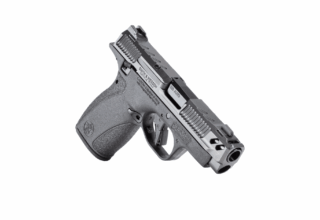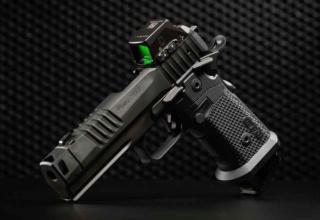If you’re looking to rekindle the fun and excitement on the range, have we got the solution for you!
It’s no surprise that conventional handgun chatter almost always centers on semi-auto pistols—specifically, those of the tactical/defensive persuasion. Sure, these are the go-to choices for most carry concealed practitioners and local IDPA-style competitive shooters, but for many firearms enthusiasts, the “tactical first” approach has become something of a rut.
We recently “rediscovered” how to put a little spice back into our range days—not by pursuing the outer edge of handgun technology, but by going the opposite direction. That’s right…the good ol’ single-action revolver. For a handgun, it doesn’t get much simpler than this. What’s more, we were surprised at just how smooth and accurate the old-school hardware can be.
[quotes quotes_style=”bquotes” quotes_pos=”center”]”This is the iconic model that won the West… or made a mess of it, depending on your perspective.”[/quotes]

About a month ago, we ordered an 1873 Single Action Revolver from Traditions Firearms. Although best known for their classical to cutting-edge muzzleloading rifles, Traditions also offers blackpowder pistols as well as those of the single-action cartridge variety based on the original 1873 Colt Single Action Army revolver. Even if you are a newcomer to the handgun world, you’re already familiar with the “Peacemaker” style handgun. This is the iconic model that won the West (or made a mess of it, depending on your perspective).

While there are several 1873 SAA clones and replicas produced by various manufacturers, we selected a Traditions model (produced in Italy by Pietta) for a few reasons. First, Traditions, as the company’s name implies, has planted a large flag on the heritage firearms landscape, having years of experience making traditional-style muzzleloading rifles and pistols. Second, we’ve handled Traditions’ 1873 Single Action Pistols at various trade shows over the years and have been drawn to their overall feel and quality. Third, these pistols are priced with a high quality-to-cost ratio in mind.
The Traditions 1873 Single Action Revolvers come in two primary flavors. The uplevel Frontier line is distinguished by its checkered, two-piece walnut grip and color case hardened frame (deep bluing and nickel steel are also offered). The Rawhide series is only slightly more basic. It comes with a non-checkered walnut grip and matte black finish. All center-fire calibers (.45LC, .357 Mag, .44/40, and .44 Mag) feature six-shot cylinders while the rimfire calibers (.22LR and .22 Mag) boast 10-round cylinders. Available barrel lengths across both lines are 4.75, 5.5, and 7.5 inches.
 Our selection of the lot was the Frontier model with a 5.5-inch barrel chambered in .45 Long Colt. For the finish, we went with the color case hardened frame because the multi-hued presentation just seemed right for the vintage iron theme we’ve been craving.
Our selection of the lot was the Frontier model with a 5.5-inch barrel chambered in .45 Long Colt. For the finish, we went with the color case hardened frame because the multi-hued presentation just seemed right for the vintage iron theme we’ve been craving.
When the Frontier finally arrived and we got to open the box, we weren’t disappointed. Aesthetically, the revolver hit all the right notes. The deep bluing of the barrel, cylinder, and trigger guard was flawless, and the color case hardened frame delivered the subtle “antique patina” we were looking for.
 Although barrel lengths in a Peacemaker-style revolver come down to personal preference and intended use (the longer the barrel and sight picture the greater the accuracy at longer distances), the 5.5-inch barrel provides effortless balance, hitting that sweet middle ground of aesthetics, accuracy, and ergonomics. An unexpected feature that we had not noticed in our previous handling of the Frontier was the aggressiveness of the walnut grip checkering. The stipling effect makes this grip downright sticky. Combined with its exquisite balance, this is a handgun that provides confidence for one-handed “cowboy style” shooting.
Although barrel lengths in a Peacemaker-style revolver come down to personal preference and intended use (the longer the barrel and sight picture the greater the accuracy at longer distances), the 5.5-inch barrel provides effortless balance, hitting that sweet middle ground of aesthetics, accuracy, and ergonomics. An unexpected feature that we had not noticed in our previous handling of the Frontier was the aggressiveness of the walnut grip checkering. The stipling effect makes this grip downright sticky. Combined with its exquisite balance, this is a handgun that provides confidence for one-handed “cowboy style” shooting.
Enough of the benchtop review.
Within hours of picking up the gun at our dealer, we were off to the range with a stash of .45LC to see what this pistol was all about. Mechanically, the 1873 Single Action Revolver is similar to the original, with at least one important exception. Pietta engineered a transfer bar safety into this platform. In short, the transfer bar safety is designed to allow the hammer to transfer energy to the frame-mounted firing pin only if the trigger is pulled once the hammer is in the fully cocked position. This system prevents accidental discharge due to a drop-fire or a blow to the hammer even if a cartridge is in the cylinder and in front of the firing pin. With the transfer bar safety, you can safely carry a full cylinder.
Loading the pistol is simple enough. Pull the hammer back to its halfway position and the cylinder is free to rotate toward the loading gate. Open the gate and insert the cartridges into the chambers.
We found the cartridge fitment to be “precise”—not unusually tight, but not loosey-goosey, either. Credit that to the exact engineering we found throughout the action. Speaking of action, the hammer, trigger, and cylinder runs through their respective positions with silky precision. The cylinder timing seemed to be spot on as far as we could tell without instrumental measurements. As for the trigger, ours proved remarkably crisp and light, with no discernible travel.
Given that the first rounds out of any firearm are kind of like a first date, we weren’t expecting to shred bullet holes. Well, we did. At ten yards out, the entire cylinder’s worth of .45LC cut each other up. The group was an inch to the left, but tight beyond our expectations.
Moving out, the rounds loosened up a bit, but we’ll claim too much coffee and shivering in 30-degree weather for some of that. Overall, we were highly impressed with the revolver’s accuracy potential. In this case, a decent barrel length, exceptional balance, crisp trigger, and top-notch engineering combined to perform far better than our skills could fully exploit. The gun did shoot consistently left of center. More downrange rounds and us getting used to the transition from a semi-auto platform to a cowboy profile should fix that (or we’ll just have to nudge the front sight a tad).
Speaking of fix, we can’t wait to get our next one on. After years of shooting only semi-autos with a defensive approach, it was liberating (and somewhat addictive) to employ a handgun with the kind of elegance and simplicity that the Traditions 1873 Single Action Revolver delivers. Heck, some close-range hunting or maybe local cowboy action competition might be in the offing!
- We Were Shocked at How Accurate This One Is… - January 3, 2017
















